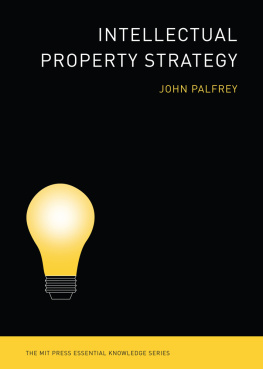THE EUREKA MYTH
CREATORS, INNOVATORS, AND EVERYDAY INTELLECTUAL PROPERTY
Jessica Silbey
STANFORD LAW BOOKS
An Imprint of Stanford University Press
Stanford, California
Stanford University Press
Stanford, California
2015 by the Board of Trustees of the Leland Stanford Junior University. All rights reserved.
No part of this book may be reproduced or transmitted in any form or by any means, electronic or mechanical, including photocopying and recording, or in any information storage or retrieval system without the prior written permission of Stanford University Press.
Printed in the United States of America on acid-free, archival-quality paper
Library of Congress Cataloging-in-Publication Data
Silbey, Jessica, author.
The eureka myth : creators, innovators, and everyday intellectual property / Jessica Silbey.
pages cm
Includes bibliographical references and index.
ISBN 978-0-8047-8337-8 (cloth : alk. paper) ISBN 978-0-8047-8338-5 (pbk. : alk. paper)
1. Intellectual propertyUnited States. 2. Creation (Literary, artistic, etc.) 3. Technological innovationsUnited States. I. Title.
KF2979.S59 2015
346.7304'8dc23
2014028756
ISBN 978-0-8047-9353-7 (electronic)
Designed by Bruce Lundquist
Typeset by Newgen in 10/15 Sabon
To Robert and Susan Silbey
Contents
Acknowledgments
WRITING THIS BOOK was challenging and fun. Yet I am glad to be done. By contrast, conducting the interviews and speaking with the people whose stories fill the pages that follow was not only fun; I had a hard time stopping. Long after my fiftieth interview, I continued to seek out people with whom to speak. The interviews were pure pleasure. I could have spent many more years sitting with artists and scientists and lawyers and businesspeople talking about the creative and innovative work in which they engage. I still struggle to resist the temptation to add to my interview list. I still carry my digital recorder with me. But the book needed to be written, especially when the patterns within the interviews became sufficiently clear, convincing me that despite the diversity of interview subjects, I had enough data to investigate and analyze their common themes. And so first, I thank the people who sat with me and shared details about their work and their professional biographies and aspirations. I am grateful to you. And I am sure the stories you shared with me are the reasons most people will read this book.
I had many voices in my head as I wrote this book, voices encouraging and challenging me to be more precise, more analytical, more ambitious. Some of those voices are from a long time ago when I began my career as a writer and teacher. They are stuck in my head for good, and I am grateful for them: James Boyd White, Joseph Vining, Tom Green, three teachers who long ago helped me think hard about law as a system of language and meaning that is deeply human and worth spending a life writing about. Other voices are from the intellectual property community, a community of which I am so glad to be a part, a community that is open, embracing, constantly evolving and looking to the future with excitement but without losing track of its human values and historical roots. Voices from this community for which I am particularly grateful and who lent their invaluable support include Barton Beebe, Julie Cohen, Peter Decherney, Stacey Dogan, Brett Frischmann, Wendy Gordon, Laura Heymann, Mark McKenna, Bill Patry, Rebecca Tushnet, and Martha Woodmansee. I also thank these very special friends who supported me in ways that only dear friends can, by listening to me obsessively talk and talk and talk about this project. I am blessed they care so much about me and push me to do this work better. Thank you to Elizabeth McGeveran, Bill McGeveran, Mary-Rose Papandrea, and Elizabeth Trujillo.
Suffolk University Law School, the administration, my faculty colleagues, and the law librarians, especially Rick Buckingham, provided me with substantial support over the years. Also, I was particularly lucky to have stellar research assistance from Todd Thurheimer, whose experience as a computer engineer, a musician, and a budding lawyer were invaluable to this project. I could not have made the progress I did without Todd to work the data with me. Todds perspectives and insights were often different than mine and therefore he added significant dimensionality to the project. I owe him a huge debt of gratitude.
There is a hidden gem (or perhaps no longer so hidden!) in Nausicaa Renner. At the tail end of this project, she became part of this book and a partner. Sharp and wise with language, she improved this book immensely. I also must thank the editors at Stanford University Press, especially Michelle Lipinski and Kate Wahl, and the anonymous peer reviewers, all who dedicated time to improving this book.
I have been lucky to share this work as it evolved with colleagues and students around the United States and abroad, at Boston University Law School, Harvard University Law School, Harvard School of Education (and Project Zero), New York University, Yale Law School, University of Pennsylvania, Cardozo Law School, University of Maine Law School, American University Washington College of Law, Northeastern University Law School, University of Washington School of Law, Case Western Reserve School of Law, Chicago-Kent College of Law, Loyola University of Chicago School of Law, Loyola Law School of Los Angeles, Osgoode Hall at York University, the London School of Economics, and the International Society for the History and Theory of Intellectual Property in London and Paris. Questions asked during these visits enriched my engagement with the material. And the enthusiasm of colleagues at these institutions helped propel me when the project felt overwhelming and unwieldy.
My husband, Keith Dresser, and our daughters, Charlotte and Harper, deserve a prize for patience and resilience in the face of my obsessive work habits. They are my prizes. I do not take them for granted, but knowing they would be there each day, supportive and with hugs, made the long nights easier. I would be remiss if I did not also thank Ruth Walsh, whose unfailing presence in our family life since its beginning has made everything better.
My mother read every word of this book. She remains my first and most influential teacher, and, I believe, my best champion. I am proud to be her daughter, and I hope this book reflects how extraordinary a teacher she is, even of stubborn students. This book is dedicated to her and to my father, both who earned deserved reputations as gifted and generous teachers and scholars in their fields. My father died while I was writing this book. He was particularly passionate about art, music, and literature and was himself a superb scientist. This book made perfect sense to him. When I learned that, I knew I was onto something.
Introduction
I wanted to make paintings. I wanted to publish them. But I didnt want to own them.... Its like having a litter of puppies and you [find] a good home for each one of them.
Joan, an internationally known public artist
WHAT COULD IT MEAN for this artist, Joan, to compare her paintings to cuddly canines? In what plausible way is an artists creative process like the daily labor and intensive care that is required to nurture a pregnant bitch and whelp her puppies? Is the professional satisfaction in building an appreciative audience and receiving feedback from the art world like the satisfaction received from childrens joy when they take a puppy home? What does it mean to own a painting (or a puppy) when the purpose of making it is to give it away? Does one author puppies the way one authors a painting, hoping to retain some subsequent control over attribution and integrity?
Next page







